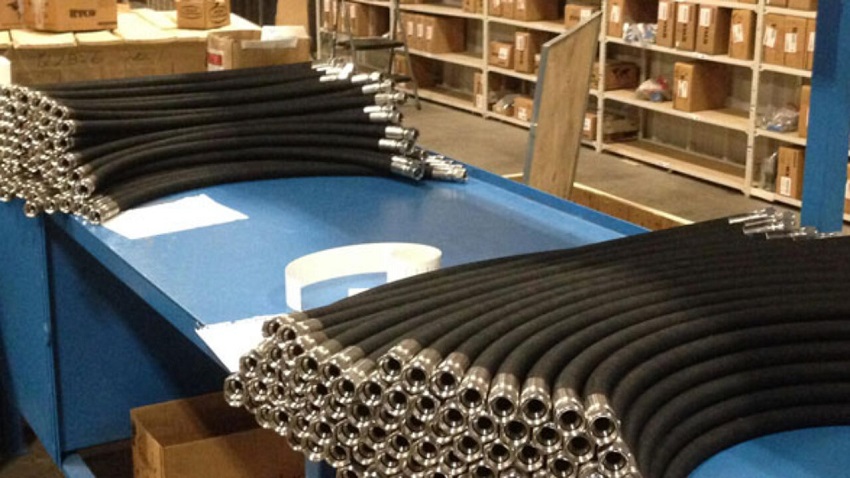Hydraulic hoses are vital components of hydraulic systems that transmit power and fluid within machinery and equipment. However, excessive pressure on hydraulic hoses can lead to leaks, ruptures, and even accidents. In this article, we will explore how to relieve pressure on hydraulic hoses and ensure their optimal performance.
Hydraulic systems are widely used in various industries, including construction, manufacturing, and transportation. These systems rely on hydraulic hoses to carry hydraulic fluid, enabling power transfer and control of machinery. Understanding the causes of pressure on hydraulic hoses and the importance of relieving that pressure to maintain their longevity and prevent potential hazards is crucial.
Understanding Hydraulic Hoses
Components of a Hydraulic Hose
Hydraulic hoses have several key components that provide reliable fluid transmission. These components include the inner tube, reinforcement layer(s), and outer cover. The inner tube carries the hydraulic fluid, while the reinforcement layer(s) provide strength and flexibility. The outer cover protects the hose from external factors such as abrasion, weather conditions, and chemicals.
Common Causes of Pressure on Hydraulic Hoses
Pressure on hydraulic hoses can arise due to various factors. Some common causes include excessive fluid flow, temperature fluctuations, incorrect hose routing, improper installation, and over-tightening of fittings. Understanding these causes is essential in implementing effective measures to relieve pressure and maintain the integrity of the hydraulic system.
Importance of Relieving Pressure
Relieving pressure on hydraulic hoses is crucial for several reasons. First and foremost, it helps prevent leaks, which can lead to fluid loss, machinery malfunctions, and environmental contamination. Additionally, excessive pressure can cause the hose to burst, posing safety risks to operators and nearby personnel. By relieving pressure, you ensure the longevity and reliability of your hydraulic system while promoting a safe working environment.
Tips to Relieve Pressure on Hydraulic Hoses
Regular Inspection and Maintenance
Regular inspection and maintenance are vital in preventing pressure buildup on hydraulic hoses. Inspect the hoses for signs of wear, such as cracks, bulges, or abrasions. Replace any damaged hoses immediately. Establishing a maintenance schedule and following manufacturer guidelines for inspection intervals and procedures is recommended.
Proper Hose Routing
Correct hose routing minimizes the risk of pressure buildup. Ensure that hoses are not bent excessively or twisted, which can restrict fluid flow and cause pressure to accumulate. Avoid placing hoses near sharp edges or hot surfaces that may damage or weaken them. Proper hose routing ensures optimal performance and reduces the likelihood of pressure-related issues.
Correct Hose Length
Using the correct hose length is essential to relieving pressure effectively. Avoid using hoses that are too short or too long for the intended application. Too short hoses may cause excessive tension, leading to pressure buildup. Conversely, too-long hoses may have a higher risk of entanglement or kinking, resulting in restricted fluid flow and increased pressure.
Using Pressure Relief Valves
Pressure relief valves are valuable tools for maintaining optimal pressure levels in hydraulic systems. These valves automatically open to release excess pressure, preventing damage to hoses, fittings, and other components. Install pressure relief valves in appropriate locations within the hydraulic system to safeguard against pressure-related incidents.
Avoiding Abrasion and Over-Tightening
Abrasion and over-tightening are common mistakes that can increase pressure on hydraulic hoses. Ensure hoses are protected from abrasive surfaces, vibrations, and potential impact. Additionally, avoid over-tightening fittings, as this can distort the hose and restrict fluid flow, leading to pressure buildup. Use torque wrenches or follow manufacturer specifications for appropriate fitting tightness.
Common Mistakes to Avoid
While understanding how to relieve pressure on hydraulic hoses is essential, it is equally important to be aware of common mistakes that can hinder your efforts. Avoid these pitfalls to ensure the effectiveness of your pressure relief measures:
- Neglecting regular inspection and maintenance routines.
- Improper hose routing and installation.
- Using incorrect hose lengths for the application.
- Failure to install pressure relief valves where necessary.
- Negligence in protecting hoses from abrasion and over-tightening.
By avoiding these mistakes and implementing the tips mentioned earlier, you can significantly reduce pressure-related issues and ensure the longevity of your hydraulic hoses.
Conclusion
Relieving pressure on hydraulic hoses is critical to maintaining their performance and preventing potential hazards. By understanding the causes of pressure and implementing effective measures such as regular inspection, proper hose routing, using the correct hose length, installing pressure relief valves, and avoiding common mistakes, you can optimize the reliability and safety of your hydraulic system.










